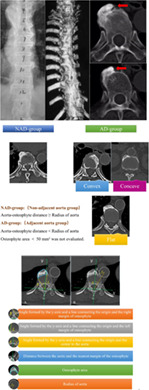- Record: found
- Abstract: found
- Article: found
Not All Osteophytes Are Located on the Right Side of the Vertebrae in Diffuse Idiopathic Skeletal Hyperostosis: A Quantitative Analysis in Relation to the Position of Aorta

Read this article at
Abstract
Objective
Diffuse idiopathic skeletal hyperostosis (DISH) is characterized by osteophytes in the anterior vertebrae, and the presence of aorta may have an impact on their formation. However, the anatomical positional relationship between the aorta and osteophytes in patients with DISH remains controversial. This study aimed to evaluate the position of osteophytes in relation to aorta in DISH, and the influence of aortic pulsation on the formation of osteophytes from the perspective of morphology.
Methods
We conducted a retrospective review of 101 patients diagnosed with DISH and symptomatic lumbar spinal stenosis between June 2018 and December 2021. A total of 637 segments with heterotopic ossification in DISH were used for quantitative measurements on CT scans. The Cartesian coordinate system was built up on the axial CT scans to reflect the relative position between aorta and osteophytes. Osteophytes were divided into adjacent aorta group (AD group) and non‐adjacent aorta group (N‐AD group). In terms of the morphology, osteophytes in the AD group were further divided into convex, flat, and concave types. The relative position between aorta and osteophytes, and the aorta‐osteophyte distance and morphology of osteophytes were compared. Univariate analysis of variance was performed for multiple groups, and two independent‐samples t‐tests were used for two groups.
Results
From T5 to L4, aorta gradually descended from left side to middle of vertebrae, and osteophytes gradually shifted from right side of vertebrae (T5‐T10) to bilateral sides (T11‐L4). Of 637 osteophytes in DISH, 60.1% (383/637) were in AD group, including convex type 0.6% (4/637), flat type 34.7% (221/637), and concave type 24.8% (158/637). The N‐AD group accounted for 39.9% (254/637). Flat osteophytes were concentrated in T5‐T12, while concave osteophytes in T11‐L4. Overall, the aorta‐osteophyte distance of concave type was significantly smaller than that of flat type.
Abstract
DISH is characterized by anterior heterotopic ossification of spine, avoiding the aorta. Segments with osteophytes were grouped according to the morphology in the study, in order to investigate the positional relationship between the aorta and osteophytes and the influence of the aorta on the formation of the osteophytes in DISH.
Related collections
Most cited references23
- Record: found
- Abstract: found
- Article: not found
Radiographic and pathologic features of spinal involvement in diffuse idiopathic skeletal hyperostosis (DISH).
- Record: found
- Abstract: found
- Article: not found
Diffuse idiopathic skeletal hyperostosis: clinical features and pathogenic mechanisms.
- Record: found
- Abstract: found
- Article: not found
